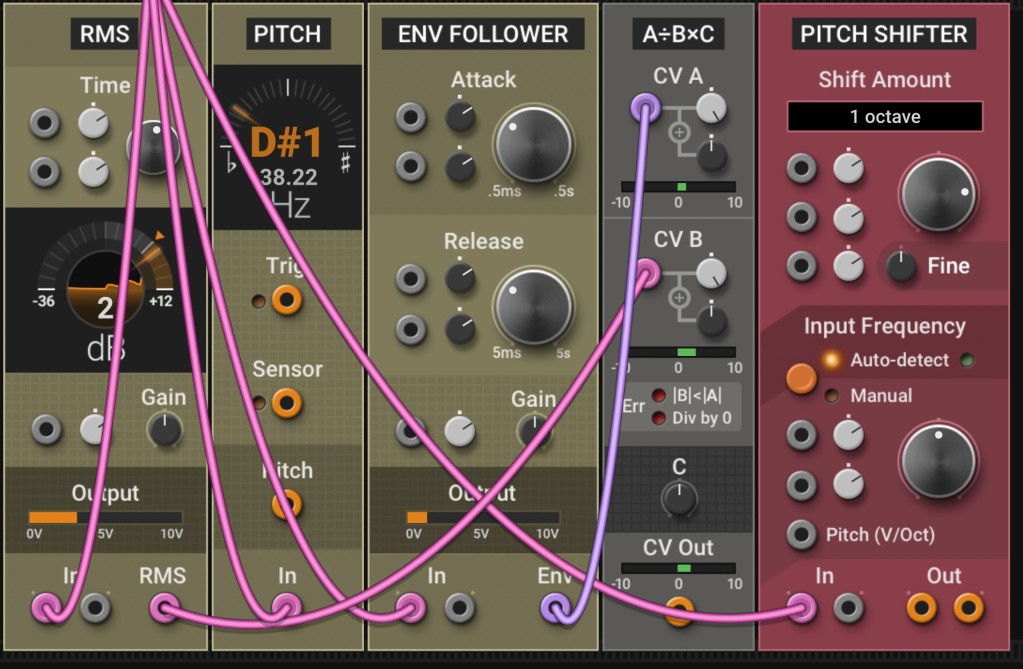Applied Acoustics Systems’ software modular, Multiphonics CV-2, just got a big update with the ability to follow an input’s dynamic level and pitch, plus new modules for pitch shifting and working with control voltage math.
My love for AAS with Multiphonics still continues unabated. It’s perhaps the most conservative software modular of the moment, but it’s also arguably the most efficient – I don’t think there’s another modular plug-in with which you can get in, patch, and get out quite this quickly, whether using it as a sound source or an effect. (Fight me on this, really! Actually now I can sing back my response through these inputs.) When I want a ton of modules, of course, Reaktor Blocks and VCV Rack win handily (with Softube Modular and Cherry Voltage Modular in pursuit). But Multiphonics is uniquely well designed, focused on the basics, and exquisitely documented. This is like coming back to a Doepfer system after playing around with more exotic, sprawling rigs with lots of unitaskers and toys.
This 2.2 release is dubbed the “Dynamic Pitch Update,” which you should probably read as Dynamics and Pitch. You get five new modules:
This really fills in a big gap since CV-2 added audio input. You could certainly patch audio signal directly and use it as voltages for some crude pitch or amplitude control input, but it’s far more effective having tools to let you dynamically analyze that signal and tame the results. And that in turn opens up some truly creative possibilities.
Let’s tour those modules quickly:

The Pitch Detector works a lot like a simple portable tuner. Input audio, and when it detects a quantized (12-TET) pitch, it outputs a gate (Sensor), trigger (Trig, only for newly detected pitches), and 1V/oct pitch output. Now, what’s interesting about this is really the trigger and gate outputs, because then you can trigger an envelope or other event with the pitch detection.
I do wish AAS would support alternate tunings here, though – I’d love to remap that via Scala, for instance.
Pitch Shifter is easy to grok, too: you just take an amount in semitones, and fine tune with the Tune knob. You can auto-detect for detection just like in the Pitch Detector, or manually tune to a frequency you want in manual mode – which means that yes, you could use this for non 12-TET tunings, though again it’d be great to have the ability to work with those directly in the interface in addition to being able to tune them by ear.
Now where this gets interesting is, you can use this as a granular resynthesizer – see the manual for a taster.
The RMS and Envelope Follower are best understood as a pair. The layouts are straightforward. The Envelope Follower gives you Attack and Release controls plus output gain and outputs an envelope; RMS gives you an overall Time control. RMS helps give you an averaged time over a larger window; Envelope Follower is better at responding to transients and momentary dynamic changes. But there’s helpful interactive visual feedback for all of this – hey, we are in software; we don’t have to squint at an LED lamp. And you have CV control over everything. As usual, Multiphonics is deceptively simple; there’s a lot more you can do with clever patching.
A÷B×C (mmm, math!) is a division CV comparator with scaling. Take an A input + the A constant, divide by B input + B constant, and scale by C. This is technically “limited” division in that it occurs within reasonable voltage ranges, so you don’t get the outputs you would with a true division or digital division. But it’s released with this particular update because you can use it with the RMS and Envelope Follower to build your own very basic compressor. You can then invert the envelope from the RMS or Envelope Follower, giving you compression each time you cross a threshold – see the manual on that; I can’t say it any better than they did. But I could imagine this being used with other modules or even as a way of messing with envelopes created by the pitch detection, so it’s also ripe for some abuse – time to experiment.
There’s just so much you can do with this – it goes way, way beyond what I think my description of these modules suggests. Here’s a great patch example with Adam, and it helps illustrate that isn’t just “oh, I’ll sing into my subtractive synth.” It’s IDMilicious:
So this update is easy to recommend – even though I’ll keep repeating my plea for AAS to keep fleshing out what’s on offer. I’m a bit surprised that there’s still no audio input in the standalone version, for instance, though you can simply load into your DAW (or a host like MainStage or Steinberg VST Live.
But what Multiphonics does, even if it’s sometimes limited, it does exceptionally well.
Applied Acoustics Multiphonics CV-2 – latest update
Oh, and bonus – it’s on sale now, so about a hundred bucks if you don’t have a license.
If you buy something from a CDM link, we may earn a commission.
AAS Multiphonics CV-2 at Plugin Boutique